| NATIVE AMERICAN ART IN THE USA |
 |
|
Native Americans have been creating what is today considered art, in unique ways, for centuries. Today, some Native American artists continue to incorporate those same styles and symbols into their work, either through entirely traditional art, or an amalgamation of contemporary techniques and the methods of their ancestors.
|
SUMMARY
| ART IN NATIVE CULTURES |
ART IN AMERICAN REGIONS |
CONTEMPORARY INDIAN ART |
| Art was abundant in almost every Native culture, though it was often not separated from the day-to-day, as it often is now. Rather, the most accomplished craftsmanship within a people's basketry, ceramics, painting, or beading was recognized and lauded, though its use would generally be practical |
There are more than 500 tribes of Native American peoples in the United States, and each region - or even each specific group - has their own traditional artistic strengths and styles. |
Today those artists who choose to follow classic Native styles may incorporate them into contemporary methods, modernize the subject matter in traditional styles, or find other ways to recognize their heritage within their artwork. |
|
| ART IN TRADITIONAL NATIVE AMERICAN CULTURES
|
 |
|
Unlike the European artist, in the time before (and even after) European contact, Native Americans (American Indians) did not work exclusively as artists. Art was generally applied to practical items, made by craftsmen, or simply by those who required them. While the difference between a well-executed and poorly executed piece of beading, dyeing, or other decorative item would be noticed, it would often be considered "effective" rather than "art".
This certainly does not mean beautiful craftsmanship, which we would today consider art, did not thrive. Different tribes and regions had - and still have - unique styles of art and decorative work. In many cases, inspiration would be drawn from natural sources - the land, sea, sky, wildlife. Other styles feature simple geometric, linear patterns.
In some cases it's believed a region or tribe's style developed from the work of a single artist, though in many cases this is difficult to trace. The idea may have come during a vision quest or a dream. Despite the lack of emphasis on art as a career, the work created by a certain person was considered their private property, and copying it was frowned upon.
Though individual Native American artists were not widely known, some artists from the late 19th and early 20th century were recognized for their contributions to Native American art, and whose style was eventually considered traditional. These artists sold their art, and in that way expanded the range of their work, and affected the economy of the tribe.
|
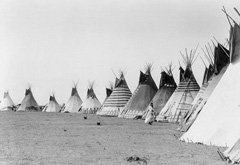
Teepees in a Blackfoot Nation reserve, 1933
|
| REGIONAL STYLES OF NATIVE AMERICAN ART
|
 |
|
As the term refers to all original inhabitants of the Americas, Native American art spans a huge range of cultures and an extensive timeline, from prehistoric to modern day.
There are many differences between the art of various cultures, but also similarities, since inspiration and borrowing of styles was common. This extends not only to visuals but materials as well, as stones, shells and other items native to one region could be traded across thousands of miles.
While the art of vastly separated tribes could have striking similarities, so too could neighboring tribes have completely disparate styles.
Southwest
- Hohokam, Ancestral Pueblo, and Mogollon tribes (as well as many other subdivisions) in the area of Arizona and New Mexico.
- Traditionally, weaving, painting, and pottery
- Geometric, lineal designs, with decorations applied to the primary material.
- Sculpture is not widely practised, though carved cottonwood "kachina" dolls, created by the people of the Hopi and Zuni tribes, are popular collectors items.
- Today, pottery is made almost exclusively for resale.
- Silver and turquoise jewelry, rugs, and other textiles are Southwestern specialties
Midwest and Great Plains
- Textiles, basketry, weaving is known of, but existing specimens are rare.
- Known through popular culture for buckskin and beadwork, feathered headdresses, quill decoration - tribes were not so homogenous.
- Porcupine quill artwork of high caliber.
- Imagery ranges from abstract and symbolic to realistic. Narratives are common.
- Face painting, clothing decoration, and highly-decorative riding equipment.
Far West, Northeast, Central South, and Southeast
- A lot of woodwork, though not much of it survives in good condition.
- Many fragments of textiles exist, as well as bone, featherwork, and hide.
- Talented potters: got amazing results from poor-quality clay.
- Delicate decoration, intricate designs, appliques
- Southeast was known for stone sculpture, rarely practised today.
- Wood sculpture continues to be popular today, as does basketry.
California Indians
- Most advanced and varied basketry known.
- Tribes: Pomo, Hupa, Yurok, Chumash, Mono-Paviosto, Washoe, Panamint, and Karok.
- Tight enough weaves to create a watertight container.
- Miniscule 1/8" baskets to massive grain-storage baskets.
- Feathers and other items woven into the strands.
Eastern Woodlands
- Three sections: Southeast, Great Lakes, and Northeast
- Woodwork, rush and hemp weaving, quill art.
- Beadwork in later times, made into necklaces, belts, panels on a weaving frame.
- Wood art used the burls (knots) on trees to carve bowls.
- Pottery rarely practised.
Northeast
- Iroquois known for False Face Society masks
- Quillwork, beadwork, woodwork, wampum belts
- Basketry, but of a lower quality than elsewhere.
Eskimo/Inuit
- Known for thoughtful and humorous artistic works
- Whale and walrus ivory carving is most common.
- Incised decoration, carving in the round, some inlay
- Charcoal from fires was rubbed into the finished carving to highlight the lines.
- Wood carving was also popular and beautiful, though much of it is gone.
- Surreal, caricature, cartoon style.
- Sculptures amalgamated from various pieces
- Today: Green and grey soapstone art since the 1950s
- Also today: Graphic art derived from Japanese printmaking.
Northwest Coast
- Using steel cutting knives, sculptors reached great skill.
- Cedar totem poles, wooden figured, masks.
- Decorated with painting and shell inlay.
- Known for suiting desired design to the shape of the material (such as animals on a totem).
- Totem poles were meant as memorials to the life of the commissioner.
- Some of the first tribes to practice metalcraft; copper formed into knives, masks, overlays, and more
- Impressive sculpture and carving by Tlingit and Kwakiutl peoples.
- In late 20th and 21st century, some nearly lost practices being revived.
|
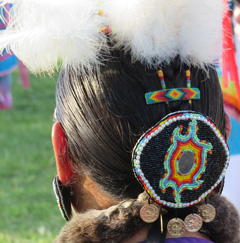
Beading was popular in the Eastern Woodlands region.
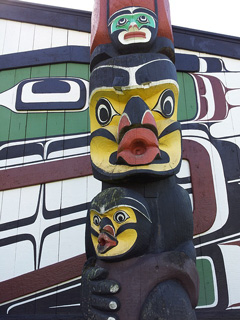
Totem pole from the Northwest Coast region.
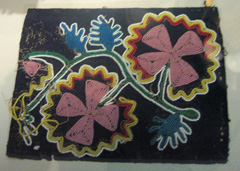
Beadwork by a Cherokee artist, 19th-Century
|
| CONTEMPORARY AMERICAN INDIAN ART
|
 |
|
Native American artists today practice a wide range of styles in countless mediums, just like any other contemporary artist. Some choose to incorporate traditional art styles into more modern, "Western" practices, while others approach the traditional methods with a modern mind. Still other artists follow the historic traditions of their ancestors or other peoples in the exact way they were originally conceived.
The subject matter of contemporary Native American art may echo the traditional focus on the natural world. Much of the modern art contemplates and asks the viewer to contemplate relations between cultures (such as the Native American and European-origin peoples). The issues and struggles faced by the artist or those in their acquaintance are common subjects, as well as the effect of modern technology and lifestyle on the planet, and other issues of our era.
FAMOUS NATIVE AMERICAN ARTISTS
Jeffrey Gibson
A Choctaw-Cherokee Indian from Colorado, Gibson is a painter and sculptor who is inspired by modern and traditional dance, dance costumes, and graffiti. His work often features beading, airbrushing, and totem poles.
Marilou Schultz
A weaving artist of Navajo descent, Schultz also incorporates spinning and dyed textiles in her work. She comes from a long line of weavers, and her artwork features intricate designs using traditional methods, which vary the texture and color of the works.
Donald and Carla Hemlock
This husband and wife artistic team are from the Kahnawake Mohawk Nation Territory. Donald creates intricate, painted wood carvings, while Carla textile work features beading and quilting with traditional and modern influences.
Gerald Clarke
An artist from the Cahuilla Band of Mission Indians, Clarke works with contemporary art styles such as installation and conceptual designs. He is also a sculptor. He uses modern materials to represent traditional ideas and encourage the remembrance of Native American history.
|
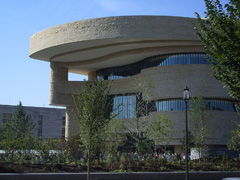
The National Museum of the American Indian has two branches: Washington DC and New York City.
|
|
For more information on the regions and cultures of the American Indian peoples, read Brittanica's extensive article on Native American Art.
If you have questions about any of our services or products, don't hesitate to contact us. Our knowledgeable staff is always happy to assist with answers, advice, or suggestions.
|
|
© 2002-2024 - KeenART Media Ltd.
|
|
| |
|

